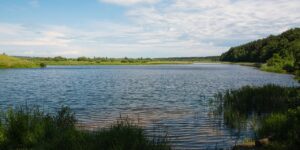We can help out bees in our neighborhood by adjusting our lawn care routine. Even small changes, like shifting your lawn mower to a higher setting, can give bees and other pollinators a better chance at survival.
Mow High for Pollinators
The first bee-friendly move you can make is to increase the height of your lawn mower. If you have plants like clover and violets in your lawn, mowing high will allow them to flower. During the spring, there aren’t many food options for pollinators. Flowers in your lawn provide a vital food source for bees and other pollinators this time of year. As an added benefit, clover also feeds your lawn by drawing nitrogen from the air and soil, making it available to your grass. Free food for pollinators and your grass!
Mowing high has another advantage too. Giving your lawn a “buzzcut” to under 3 inches tends to stress out the grass. Cutting at a longer length usually creates a healthier, greener lawn. By mowing high and letting flowers happily coexist with your grass, you support beneficial insects and improve lawn health.

Or Skip Mowing Altogether
After you become more mindful about making your yard beneficial to wildlife and allow wildflowers like clover and violets to be a part of your lawn, you might want to take things a step further. You could even skip mowing altogether during the month of May! No Mow May is a growing trend in which homeowners delay pulling out their lawnmowers for the year until May is over. Leaving your lawn alone for the month gives pollinators the best chance of finding food in your lawn. There are no hard and fast rules—you could leave your backyard or side yard un-mowed or start mowing in late May if your lawn has grown long by then. The idea is to provide foraging areas for pollinators when not much else is blooming.
After May, you can start mowing your lawn for the season. By now, now there should be more flowers in bloom outside of lawns for foraging pollinators. However, your lawn can continue to lend a helping hand to insects if you continue to mow high, allowing plants in the lawn to grow and flower between cuttings.
Or Say Goodbye to Your Lawn!
Most people want at least some lawn for their kids to play or just for the look of it. However, we likely can live with (and even enjoy having) less lawn. One great option is to replace a portion of your turfgrass with a beautiful and environmental-friendly native plant garden. If you add in native plants, you can…
- …spend less time mowing your lawn,
- …provide struggling bees and butterflies with much needed food and habitat,
- …enjoy the beauty of native flowers, shrubs, and trees,
- …reduce wet spots in your yard, especially if you create a rain garden that is designed with this outcome in mind,
- …and protect our nearby waterways from polluted stormwater runoff. Rain tends to travel across or “run off” lawn and hard surfaces while native plants infiltrate stormwater into the soil.
We work hard to keep our yards maintained, but how can we start to make our yards work for us and the local environment? We can create spaces for our families to enjoy and relax, for birds and butterflies to find refuge, for plants to grow and flourish. The changes to your lawn care routine suggested here are meant to be intentional steps to creating a functional landscape for people and wildlife.

Re-Thinking the American Lawn
The American lawn is in need of an update, but revamping our lawn care routine is not without challenges. A manicured lawn is the cultural norm—anything else looks out of place in most neighborhoods. Even if you live in a place that regulates the height of your grass and other plants, you can still work within these confines. A few environmentally-beneficial changes you can consider:
- Mow high, allowing wildflowers to grow in your grass.
- Incorporate native plants into your existing flowerbeds.
- Replace invasive shrubs like buckthorn and honeysuckle with native shrubs that provide food for birds.
- Mulch your leaves in the fall and use them in your garden or flower beds to build healthy soil.
- Leave plant stems standing over the winter and into the spring so that overwintering insect eggs can hatch.
- Let your neighbors know what you’re up to. Display a sign that says you are creating wildlife habitat and that your lawn care choices are intentional. You can certify your yard as an environmental-friendly landscape through The Conservation Foundation’s Conservation@Home program and the National Wildlife Federation.
Frankly, some of these suggestions might be a hard sell. We’ve grown attached to our lawns—some of us take pride in maintaining it to a T. If you’ve sought out this article and read this far, you’re at least considering ways to benefit the environment at home. Start small by raising the height of your mower or by transitioning a chunk of your yard to native flowers and grasses. As movements like No Mow May and Conservation@Home continue to grow, accepted lawn care practices will too.





